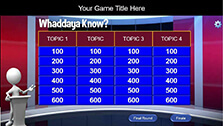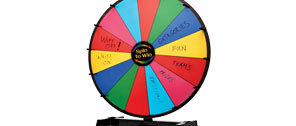Colourblind® Communication Team Building Kit is communication team building exercise. It's a proven experiential learning activity that builds communication, problem-solving, and teamwork skills. Originally developed in 1991 to train Air Traffic Controllers in Great Britain—where zero margin for error is acceptable—Colourblind® has since been used worldwide across industries, languages, and cultures. Today, it is recognized by the ILM (Institute for Leadership and Management) as a Preferred Learning Material for leadership and management training.
GAME OVERVIEW
Wearing blindfolds to ensure total dependence on verbal communication, participants work together with a set of small, irregular, colored plastic shapes. The challenge: identify two missing pieces from a complete set of 30. Success requires clear descriptive language, active listening, questioning, summarizing, and feedback to achieve a shared understanding. The exercise can run 20–40 minutes and is highly adaptable for both in-person and remote teams, making it especially valuable for customer service and support roles where clarity matters most.
LEARNING OBJECTIVES
- Develop effective two-way communication skills under challenging conditions
- Strengthen team problem-solving and collaboration
- Practice listening, questioning, and feedback for clarity
- Adapt communication styles to meet the needs of diverse teammates
- Build a common vocabulary and shared meaning around abstract concepts
- Understand cultural nuances in communication and teamwork
- Apply lessons to remote communication channels (phone, email, virtual meetings)
WHY FACILITATORS USE COLOURBLIND®
- Proven history: From Air Traffic Control training to Fortune 500 workshops, trusted for over 30 years.
- Universal relevance: Used in leadership, customer service, cross-cultural, and team development programs worldwide.
- Engaging format: Blindfolds and tactile pieces create just enough challenge to make the learning memorable.
- Scalable: Works with groups of 4–28; larger groups can assign observers to enrich the debrief.
FAQS
Q: What group size is recommended for Colourblind®?
A: The blindfolded problem-solving activity works best with groups of up to 14 participants. Larger groups can be included by assigning observer roles to watch communication patterns and contribute insights during the debrief.
Q: How much space do we need?
A: Allow enough space for everyone to sit comfortably and communicate clearly. A horseshoe-shaped arrangement of chairs is ideal, so blindfolded participants can easily receive the plastic pieces and share feedback with teammates.
Q: How does the Colourblind® game work?
A: Each participant is blindfolded and given a selection of plastic pieces. Working only with verbal communication, the group must collaborate to identify two missing shapes from a complete set of 30. The challenge highlights how complex communication becomes when visual cues are removed—and how much teams rely on clarity, feedback, and shared understanding to solve problems.
Q: How much time is needed to run the exercise?
A: Most groups complete Colourblind® in 20–30 minutes. The exact timing depends on group size, problem-solving approaches, and how effectively the team develops clear communication strategies.
Q: Why is this team building exercise valuable?
A: Colourblind® is designed to simulate real workplace communication challenges, where teams often rely on verbal channels like phone, email, or chat without shared visual context. The activity creates ambiguity and mild frustration that mirror everyday miscommunication. To succeed, participants must practice precise language, active listening, feedback, and clarification—essential skills for reducing conflict and building effective collaboration at work.
GAME ORIGINS: Colourblind® was developed in 1991 when our colleague, Dr. Geoff Cox, designed and delivered the first week of an induction training programme for Air Traffic Control cadets. Each cadet facing an intensive, demanding training programme in which teamwork and communication skills would be fundamental to success. Each, ultimately, would accept professional responsibilities which allow absolutely no margin for communication error, misunderstanding or ambiguity.
Colourblind® enabled participants to rehearse every communication skill which Air Traffic Controllers need and to highlight the problems and pitfalls which communication breakdown inevitably brings when there is no visual common ground
Since 1991 Colourblind® has been used worldwide across languages, cultures and business backgrounds, to focus on the fundamental skills of great communication.
Colourblind is also part of our Education Sector Package for those who wish to use it with students or young people in an educational setting.
SAMPLE CHALLENGE
Which are the two components that are missing from the set of shapes we have in our possession?
" I have a piece that is like a rectangle with points and a hole in the middle."
"Yes, I have one too...two points and a circular hole."
"Yes, I think I have one...does it look like a Capital A?"
"No, not an A...like a rectangle with a diamond shape lying over it..."
"Would you describe it as an arrowhead?"
"Like a triangle, but instead of having three flat sides one is an arc..."
"Does anyone know what an arrowhead is in Italian?.."
VIEW THE DEMO
INCLUDES
- 20 blindfolds (re-usable)6 puzzle pieces in each of 5 colors (total of 30 pieces)
- Facilitator Manual - full guide with set-up, delivery and review suggestions
Package Weight: 2 lbs
Colourblind is designed by RSVP Design Ltd, now validated by ILM.





















































